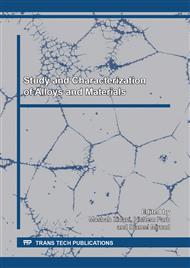[1]
Sanjeev Katoch, Rakesh Sehgal and Vishal Singh, Wear behavior of differently cryogenically treated AISI H13 steel against cold work steel, Proc I Mech E Part E: J Process Mechanical Engineering, Singh first published online: June 9, (2018).
DOI: 10.1177/0954408918781621
Google Scholar
[2]
M.M. Matlin, E.N. Kazankina, V.A. Kazankin, Effect of Ratio of Hardnesses, Load, and Roughness Parameters on Approach in Elastoplastic Contact of Rough Surfaces of Flat Parts, Journal of Friction and Wear, 2016, Vol. 37, No. 4, p.320–323.
DOI: 10.3103/s1068366616040127
Google Scholar
[3]
J. J. Coronado, Abrasive Size Effect on Friction Coefficient of AISI 1045 Steel and 6061-T6 Aluminium Alloy in Two-Body Abrasive Wear, Tribol Lett (2015) 60:40.
DOI: 10.1007/s11249-015-0615-1
Google Scholar
[4]
Andrej Lang, Manfred Klüppel, Influences of temperature and load on the dry friction behaviour of tire tread compounds in contact with rough granite, wear, Volumes 380–381, 15 June 2017, Pages 15-25.
DOI: 10.1016/j.wear.2017.02.047
Google Scholar
[5]
Yanliang Yi, et al, Effect of normal load on two-body abrasive wear of an Fe-B-Cr-C based alloy with minor Cu and Ni additions, wear. Volumes 408–409, 15 August 2018, Pages 160-170.
DOI: 10.1016/j.wear.2018.05.014
Google Scholar
[6]
V.V. Mishakin, S.N. Verichev, E.N. Razov, Investigation of the Influence of High Hydrostatic Pressure on the Abrasive Wear of Hard-Alloy Materials, Journal of Friction and Wear, 2017, Vol. 38, No. 4, p.286–291.
DOI: 10.3103/s1068366617040110
Google Scholar
[7]
V.I. Kolesnikov, A.A. Zarif'yan, A.P. Sychev, I.V. Kolesnikov, The Effect of the Coefficient of Journal Friction in Ball-and-Socket Bogie Body Pivots on the Work Done by Friction Forces in Curvilinear Motion, Journal of Friction and Wear, 2016, Vol. 37, No. 5, p.476–481.
DOI: 10.3103/s1068366616050081
Google Scholar
[8]
A. Elhadi a, et al, Study of Surface Wear and Damage Induced by Dry Sliding of Tempered AISI 4140 Steel against Hardened AISI 1055 Steel, tribology in industry, Vol. 38, No. 4 (2016) 475-485.
Google Scholar
[9]
H. Da Hai, M. Rafael, Wear 249 (2001) 626-636, a novel electrical contact material with improved self-lubrication for railway current collectors.
DOI: 10.1016/s0043-1648(01)00700-1
Google Scholar
[10]
D. Paulmier, A. Bouchoucha, H. Zaidi, influence of the electrical current on sliding contact copper-chromium steel, and connection with the environment, Vacuum, 41 (1990) 2213-2216.
DOI: 10.1016/0042-207x(90)94227-h
Google Scholar
[11]
Z.L. Hu, Z. Chen, J.T. Xia, G.Ding, Effect of the factor of the wear of carbon brushes for micromotors, Wear 265 (2008) 336-340.
DOI: 10.1016/j.wear.2007.11.003
Google Scholar
[12]
Z.L. Hu, Z. Chen, Xia J., Study on surface film in the wear of electrographite brushes against copper switches for variable current and humidity, Wear, 264 (2008) 11-17.
DOI: 10.1016/j.wear.2007.01.034
Google Scholar
[13]
N. Soda, T. Sasada, Mechanism of lubricating by surrounding gas molecules in adhesive wear, ASME. J. Lubr. Technol, 100, 492, (1978).
DOI: 10.1115/1.3453263
Google Scholar
[14]
G. Zambelli, L. Vincent, Materials and contacts, a tribological approach, Presse polytechniques and universities of Switzerland, Switzerland, (1998).
Google Scholar
[15]
Ma, X.P., Wang, L.J., Liu, C.M., Subramanian, S.V, Microstructure and properties of 13Cr5Ni1Mo0.025Nb0.09V0.06 N super martensitic stainless steel. Mater. Sci. Eng., A 539, 271– 279 (2012).
DOI: 10.1016/j.msea.2012.01.093
Google Scholar
[16]
Thibault, D., Bocher, P., Thomas, M, Residual stress and microstructure in welds of 13%Cr– 4%Ni martensitic stainless steel. J. Mater. Process. Technol. 209, 2195–2202 (2009).
DOI: 10.1016/j.jmatprotec.2008.05.005
Google Scholar
[17]
Li, C.X., Bell, T, Corrosion properties of plasma nitrided AISI 410 martensitic stainless steel in 3.5 % NaCl and 1 % HCl aqueous solutions. Corros. Sci. 48, 2036–2049 (2006).
DOI: 10.1016/j.corsci.2005.08.011
Google Scholar
[18]
R Elleuch, K Elleuch, R Mnif, V Fridrici, P Kapsa, and G Khe´lifati, Proc. IMechE Part J: J. Engineering Tribology, Vol. 220, (2006).
DOI: 10.1016/j.triboint.2005.01.036
Google Scholar
[19]
Paul C. Okonkwo, Georgina Kelly b, Bernard F. Rolfe c, Michael P. Pereira, The effect of sliding speed on the wear of steel–tool steel pairs, Tribology International 97(2016)218–227.
DOI: 10.1016/j.triboint.2016.01.030
Google Scholar
[20]
M. A. Chowdhury, M. M. Helali, The Effect of Frequency of Vibration and Humidity on the Coefficient of Friction, Tribology International, Vol. 39, pp.958-962 (2006).
DOI: 10.1016/j.triboint.2005.10.002
Google Scholar
[21]
M. A. Chowdhury, M. M. Helali, The Effect of Amplitude of Vibration on the Coefficient of Friction, Tribology International, Vol. 41, pp.307-314 (2008).
DOI: 10.1016/j.triboint.2007.08.005
Google Scholar
[22]
Sheng-cheng ZHANG, Qing-lin PAN1,2, Jie YAN1, Xing HUANG1, Effects of sliding velocity and normal load on tribological behavior of aged Al−Sn−Cu alloy, Trans. Nonferrous Met. Soc. China 26(2016) 1809−1819.
DOI: 10.1016/s1003-6326(16)64292-9
Google Scholar
[23]
Spinler, G. Machine Design, Principles and Applications, 1 Static, 2nd ed. EPFL Press and Chapman & Hall: Lausanne (2002).
Google Scholar


